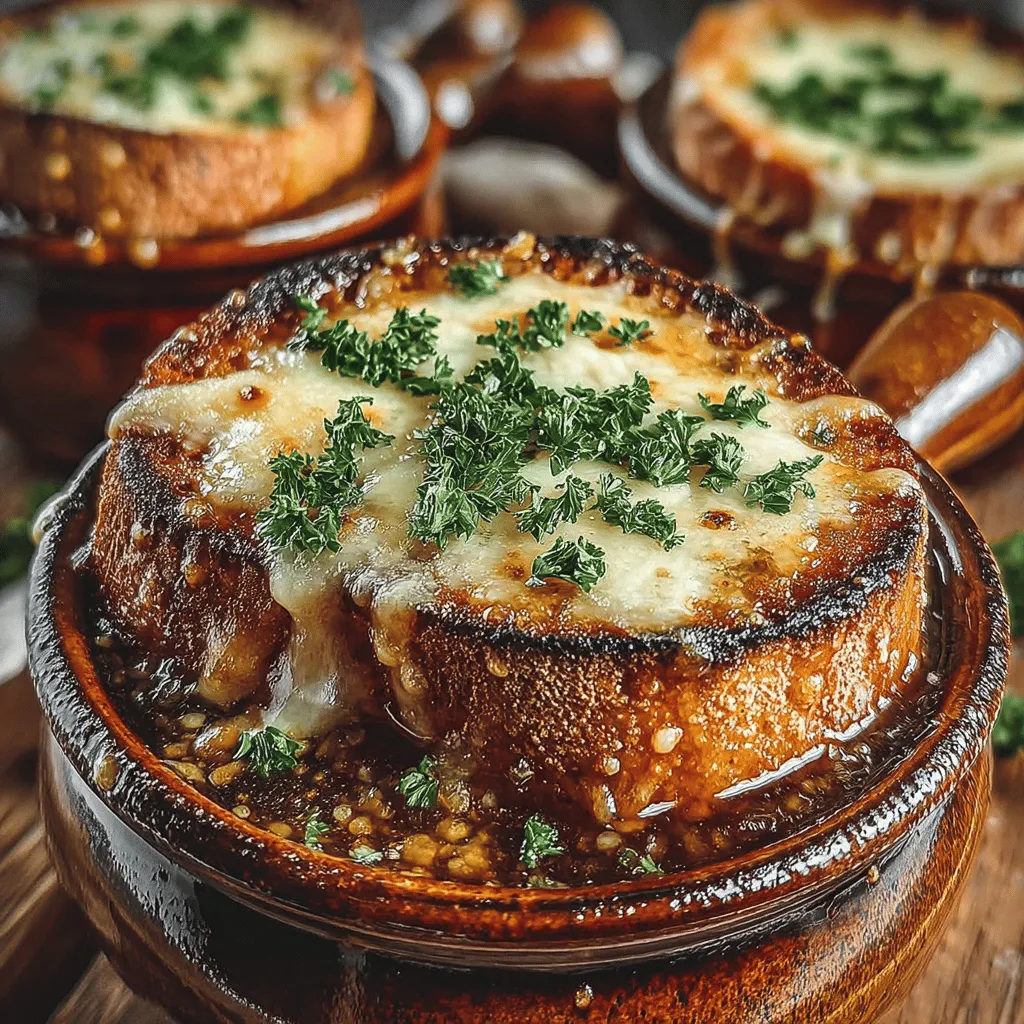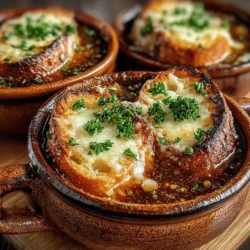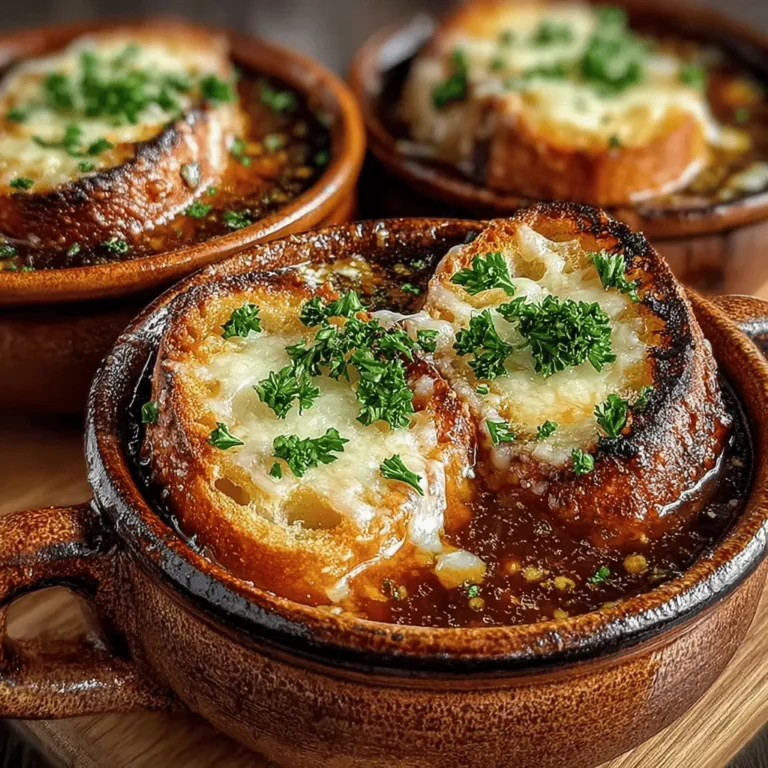Introduction to Hearty Classic French Onion Soup with Gruyère Crust
French onion soup is more than just a dish; it’s a warm embrace in a bowl, a comforting classic that has graced tables for centuries. This beloved French staple is renowned for its rich, savory profiles that bring together the sweetness of caramelized onions, the depth of a robust broth, and the indulgence of gooey melted cheese. Originating from the rustic kitchens of France, French onion soup has transcended borders and become a cherished favorite across the globe. The alluring aroma of slow-cooked onions, combined with the inviting golden crust of melted Gruyère cheese, makes this dish a perfect choice for those chilly evenings or a delightful starter for any elegant dinner.
In this article, we will delve into the art of crafting a Hearty Classic French Onion Soup with Gruyère Crust, guiding you through each step of the process. From selecting the right ingredients to mastering the cooking techniques, we will ensure that you can recreate this culinary masterpiece in your own kitchen.
Exploring the Ingredients of French Onion Soup
To truly appreciate the depth and flavor of French onion soup, it’s vital to understand its core ingredients. Each component plays a significant role in building the soup’s signature taste, making the selection and treatment of these ingredients paramount to the final outcome.
Yellow Onions: The Heart of the Soup
At the heart of French onion soup lies the humble yellow onion. These onions are prized for their natural sweetness and ability to develop deep, complex flavors when caramelized. The process of caramelization transforms the onions from their raw, sharp state into a sweet, golden mass that forms the foundation of the soup. This slow cooking process, which involves gently heating the onions until they turn soft and brown, is critical. It requires patience and attention, as the sugars in the onions gradually break down, creating a rich, sweet flavor that is essential to the soup’s character.
The Essence of Butter and Olive Oil
The next vital components are the fats—typically a combination of butter and olive oil. These ingredients serve multiple purposes in the cooking process. Butter not only adds a rich, creamy flavor to the soup but also enhances the caramelization of the onions, thanks to its milk solids. Olive oil, on the other hand, offers a lighter flavor and can be a healthier alternative. Using a blend of both ensures a balanced taste, allowing you to enjoy the full spectrum of flavors while benefiting from the health properties of olive oil.
Flavor Enhancers: Garlic and Thyme
To elevate the flavor profile of your French onion soup, garlic and thyme are indispensable. Garlic adds aromatic depth and a subtle zing that complements the sweetness of the onions perfectly. Timing is crucial when adding garlic; it should be introduced towards the end of the onion caramelization to prevent it from burning and becoming bitter. Meanwhile, thyme—whether fresh or dried—brings an earthy aroma that pairs beautifully with the other ingredients. Fresh thyme offers a more vibrant flavor, while dried thyme can provide a concentrated essence, making it a versatile choice depending on availability.
The Role of Wine and Broth
Wine plays a pivotal role in French onion soup, particularly dry white wine, which is used to deglaze the pan after the onions have caramelized. This technique lifts the fond—those delicious browned bits stuck to the bottom of the pan—infusing the soup with additional layers of flavor. As the wine cooks down, its acidity balances the sweetness of the onions. The choice of broth is equally important; beef broth offers a robust, hearty base that is traditional in many recipes, while vegetable broth provides a lighter option for those with dietary restrictions. Both options can yield a delicious soup, though they impart distinct flavors.
The Perfect Topping: Gruyère Cheese
No French onion soup is complete without its signature topping: Gruyère cheese. This Swiss cheese is celebrated for its excellent melting properties and slightly nutty flavor, which enhances the soup’s overall richness. When melted and bubbly on top of the toasted bread, Gruyère creates a delectable crust that contrasts beautifully with the warm, savory soup beneath. For those looking to experiment, alternatives such as Swiss cheese or even a blend of cheeses can provide a different taste experience, though Gruyère remains the classic choice.
Step-by-Step Guide to Making French Onion Soup
With a solid understanding of the essential ingredients, it’s time to embark on the journey of making French onion soup. The process begins with the crucial step of caramelizing the onions, which is foundational to achieving that signature flavor.
Caramelizing the Onions: The Foundation of Flavor
Start by slicing your yellow onions thinly, ensuring they are uniform for even cooking. In a heavy-bottomed pot or Dutch oven, heat equal parts butter and olive oil over medium heat. Once the fat is melted and bubbling, add the onions, stirring to coat them in the mixture. The key to perfect caramelization lies in patience—cook the onions slowly, allowing them to soften and gradually turn golden brown. This process can take anywhere from 30 to 45 minutes, so resist the temptation to crank up the heat as this can lead to burning instead of a beautiful caramelization. Stir occasionally, scraping the bottom of the pot to release any stuck bits, which will contribute to the soup’s flavor.
Incorporating Aromatics: Garlic and Flour
Once the onions are beautifully caramelized, it’s time to add the aromatic elements. Mince a few cloves of garlic and stir them into the pot, cooking for just a minute until fragrant. This is the moment to add a tablespoon of flour, which will help thicken the soup and provide a luxurious texture. Cook the flour for another minute, stirring constantly to avoid any lumps. The flour will absorb the fat and juices from the onions, creating a roux that will enhance the body of the soup.
Deglazing with Wine: Unlocking Hidden Flavors
Next comes the exciting step of deglazing the pot. Pour in your dry white wine, scraping the bottom of the pot to lift the fond that has developed during the caramelization process. This step is crucial, as it adds depth to the flavor profile of your soup. Allow the wine to simmer for a few minutes, letting it reduce and meld with the onions and flour mixture. This simmering time is also when you can add your choice of broth—beef or vegetable—allowing the flavors to blend beautifully as they cook together.
As we continue through the cooking process, we will further explore the nuances of flavor development and topping preparation, ensuring you achieve a perfect Hearty Classic French Onion Soup with Gruyère Crust. Stay tuned as we guide you through the remaining steps, bringing this comforting dish to life in your kitchen.

Creating the Perfect Broth Base
The foundation of any great French onion soup lies in the broth, and mastering this aspect is essential for achieving the rich and deep flavor that characterizes this classic dish. Start by simmering your caramelized onions with a mix of beef stock and a splash of dry white wine, which adds a layer of acidity and brightness. Allow the mixture to simmer gently for approximately 30-40 minutes. During this time, the flavors will meld beautifully, creating a deeply satisfying broth.
As your soup simmers, it’s crucial to taste and adjust the seasoning. The balance of salt and pepper can significantly affect the final outcome. You may find that depending on the saltiness of your stock or the sweetness of your onions, you might need to add a pinch more salt or a dash of pepper to achieve the desired flavor. Remember, seasoning is an art, not a science, and should be adjusted according to personal preference.
Before serving, don’t forget to remove the bay leaf. While it adds a lovely aroma during the cooking process, the bay leaf is not meant to be consumed. Its fibrous texture can be unpleasant, so make sure to fish it out just before ladling the soup into bowls.
Preparing the Baguette for Topping
The baguette is more than just a vessel for the Gruyère; it plays a crucial role in the overall texture and enjoyment of your French onion soup. Slicing your baguette into ¾-inch thick pieces allows for the ideal surface area to soak up the broth without becoming too soggy.
Toasting the baguette slices is essential for achieving the perfect texture. Preheat your oven to 400°F (200°C) and arrange the slices on a baking sheet. Brush them lightly with olive oil and sprinkle with a pinch of salt. Bake for about 10-12 minutes, or until they are golden brown and crisp. The goal is to create a crunchy surface that complements the rich, savory soup beneath. Pay close attention to the color; a golden-brown hue indicates the perfect level of toasting.
Assembling and Broiling the Soup
Now that your broth is ready and the baguette slices are toasted, it’s time to assemble the soup. Start by ladling the hot broth into oven-safe bowls, filling them about three-quarters full. The next step is to place one or two toasted baguette slices on top of each bowl, ensuring they rest snugly within the soup.
The pièce de résistance is the Gruyère cheese. Generously sprinkle shredded Gruyère over the baguette slices, making sure to cover the bread completely. For an extra touch of flavor, you can add a sprinkle of freshly cracked black pepper or a dash of paprika for a hint of warmth.
Once assembled, place the bowls on a baking sheet and transfer them to the oven under the broiler. Broil for about 3-5 minutes, watching closely to ensure the cheese melts and bubbles without burning. The goal is to achieve a beautifully golden crust that creates a delightful contrast to the savory broth below.
Serving Suggestions for French Onion Soup
Choosing the Right Bowls
When serving French onion soup, using oven-safe bowls is essential. These bowls can withstand the high temperatures of broiling and allow for even heating. Look for bowls made of ceramic or stoneware that retain heat well, ensuring your soup stays warm while you enjoy it.
In terms of style, consider using bowls with handles for easier serving and eating. Traditional French onion soup bowls often feature a rustic design that enhances the presentation. The right bowl not only serves a functional purpose but also elevates the dining experience.
Garnishing for Visual Appeal
Presentation matters, especially when it comes to a dish as visually appealing as French onion soup. A simple yet effective garnish is freshly chopped parsley. Sprinkle a small amount on top of the cheesy crust just before serving to add a pop of color and a hint of freshness. This contrast between the vibrant green of the parsley and the golden-brown cheese creates an inviting presentation.
Furthermore, a well-garnished dish can enhance the overall dining experience, making it feel special. Consider serving your soup with a slice of lemon on the side for an additional burst of brightness that diners can choose to squeeze over their soup.
Pairing Recommendations
French onion soup is a versatile dish that pairs wonderfully with various sides and beverages. A crisp green salad with a tangy vinaigrette complements the richness of the soup, providing a refreshing contrast. Additionally, serving it alongside a platter of charcuterie and cheeses can create a delightful spread for a cozy dinner.
For beverages, a dry white wine, such as Sauvignon Blanc or a light-bodied red, like Pinot Noir, enhances the flavors of the soup. You might also consider serving it with a classic French baguette or a selection of artisan bread for dipping.
Nutritional Benefits of French Onion Soup
Understanding Caloric Content and Nutritional Value
While French onion soup is a comforting dish, it also offers several nutritional benefits. A standard serving typically contains around 250-300 calories, depending on the amount of cheese and bread used. The primary ingredient, onions, are rich in antioxidants, particularly quercetin, which has anti-inflammatory properties and supports heart health.
Additionally, the cheese, especially Gruyère, is an excellent source of calcium, critical for bone health. When combined with the nutrients from the broth and any added vegetables, French onion soup can be a wholesome meal option.
Vegetarian and Dietary Modifications
For those following a vegetarian diet, adapting this recipe is simple. Replace the beef stock with a high-quality vegetable broth to maintain the depth of flavor. You can enhance the umami factor by adding a splash of soy sauce or miso paste to the broth.
For gluten-free options, consider using gluten-free baguette alternatives or even crustless bread made from gluten-free grains. This way, you can enjoy the same comforting flavors without compromising dietary restrictions.
Conclusion: The Timeless Appeal of French Onion Soup
French onion soup is more than just a comforting dish; it is a celebration of flavors that has stood the test of time. By understanding the ingredients and mastering the preparation steps, anyone can create this delightful soup at home. Whether enjoyed on a chilly evening or served at a gathering, this Hearty Classic French Onion Soup with Gruyère Crust is sure to satisfy and impress all who partake.
Embrace the culinary journey of this beloved French classic and savor the warmth and richness it brings to your table. With each spoonful, you’ll be transported to a quaint Parisian bistro, where the aroma of caramelized onions and melting cheese fills the air. So gather your ingredients, invite some friends, and let the cooking begin—your taste buds will thank you.


